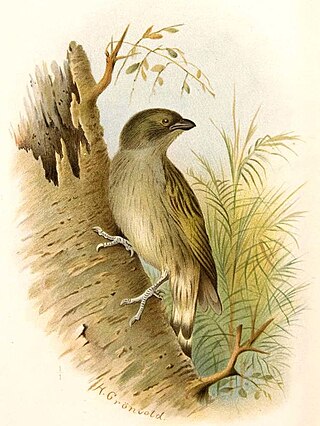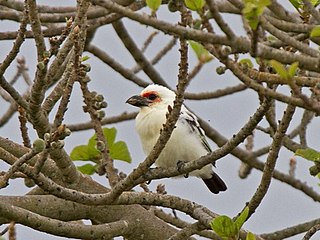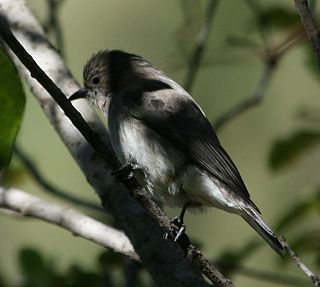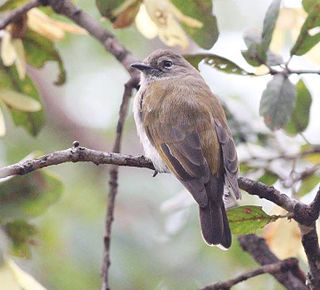
Honeyguides are near passerine birds in the order Piciformes. They are also known as indicator birds, or honey birds, although the latter term is also used more narrowly to refer to species of the genus Prodotiscus. They have an Old World tropical distribution, with the greatest number of species in Africa and two in Asia. These birds are best known for their interaction with humans. Honeyguides are noted and named for one or two species that will deliberately lead humans directly to bee colonies, so that they can feast on the grubs and beeswax that are left behind.

The greater honeyguide is a bird in the family Indicatoridae, paleotropical near passerine birds related to the woodpeckers. Its English and scientific names refer to its habit of guiding people to bee colonies. Claims that it also guides non-human animals are disputed.

The yellow-rumped honeyguide is a sparrow-sized bird in the honeyguide family that is found in Asia, mainly in montane forests along the Himalayas. They are very finch-like but the feet are strong and zygodactyl, with two toes facing forward and two backward. They perch on honeycombs and feed on wax. Males tend to be territorial and stay near honeycombs while females and juveniles forage widely. They are brood parasites, laying their eggs in the nests of tree-hole breeders, possibly barbets.

The Malaysian honeyguide is a bird in the family Indicatoridae, which are paleotropical near passerine birds related to the woodpeckers. The species is native to Southeast Asia.

Sjöstedt's greenbul is a species of songbird in the bulbul family, Pycnonotidae. It is found in western and central Africa.

The honeyguide greenbul is a species of songbird in the bulbul family, Pycnonotidae. It is widespread throughout the African tropical rainforest.

The swamp palm bulbul, is a species of songbird in the bulbul family, Pycnonotidae. It is monotypic within the genus Thescelocichla.

The Abyssinian scimitarbill is a species of bird in the family Phoeniculidae. It is found in Djibouti, Ethiopia, Kenya, Somalia, South Sudan, Tanzania, and Uganda. The Abyssinian scimitarbill is known to be insectivorous like other members of the Phoeniculidae family. They have also been observed to have their nests parasitized by the greater honeyguide species of bird.

The least honeyguide is a species of bird in the family Indicatoridae. It is found in sub-Saharan Africa from Guinea-Bissau to South Sudan and southwards to Angola and Zambia.
The spotted honeyguide is a species of bird in the family Indicatoridae. It is found in Angola, Benin, Cameroon, Central African Republic, Republic of the Congo, Democratic Republic of the Congo, Ivory Coast, Equatorial Guinea, Gabon, Gambia, Ghana, Guinea, Guinea-Bissau, Liberia, Mali, Nigeria, Senegal, Sierra Leone, South Sudan, Togo, and Uganda.

The pallid honeyguide is a species of bird in the family Indicatoridae. The species is also known as the eastern least honyeguide. It is found in Angola, Democratic Republic of the Congo, Kenya, Malawi, Mozambique, Tanzania, Uganda, Zambia, and Zimbabwe.

The lesser honeyguide is a species of bird in the family Indicatoridae.

The scaly-throated honeyguide is a species of bird in the family Indicatoridae.

Willcocks's honeyguide is a species of bird in the family Indicatoridae. It is found mainly throughout the African tropical rainforest.

Chaplin's barbet or the Zambian barbet, is a bird species in the family Lybiidae, which was until recently united with the other barbets in the Capitonidae. This bird was named in honor of Sir Francis Drummond Percy Chaplin, a former colonial governor. The species was renamed to emphasize its status as Zambia's only true endemic bird species. It is endemic to South Central Zambia and is restricted to the area between the Upper Kafue River to Kabanga in the Kalomo District. Its natural habitats are moist savanna and arable land. It is threatened by habitat loss. It was formerly classified as a Near Threatened species by the IUCN. But new research has shown it to be rarer than it was believed. Consequently, it is uplisted to Vulnerable status in 2008.
The lyre-tailed honeyguide is a species of bird in the family Indicatoridae. It is monotypic within the genus Melichneutes. It is found in the African tropical rainforest :

The yellow-footed honeyguide is a species of bird in the family Indicatoridae. It is found in Cameroon, Guinea, Liberia, Sierra Leone, Ivory Coast, Ghana and Nigeria. Its natural habitat is subtropical or tropical moist lowland forests. It is threatened by loss of its forest habitat.

Cassin's honeybird, also known as Cassin's honeyguide, is a species of bird in the family Indicatoridae.

The brown-backed honeybird, also known as Wahlberg's honeybird, Wahlberg's honeyguide and sharp-billed honeyguide, is a species of bird in the family Indicatoridae. This bird is named after the Swedish naturalist Johan August Wahlberg.

The green-backed honeybird, also known as the eastern green-backed honeyguide, green-backed honeyguide and slender-billed honeyguide, is a species of bird in the family Indicatoridae.



















